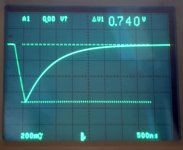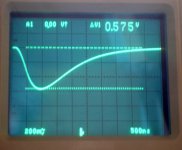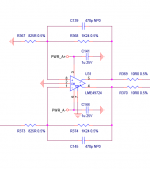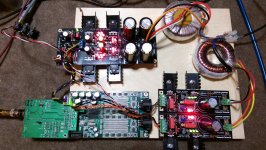Seeing this renewed interest in power supplies for the DAM I thought I would tell you what nige2000 has done. I am in the process of getting the parts to copy his efforts.
Nige is a big believer in the A123 28850 batteries. They are the best power supply caps I have ever heard.
Nige is using regulators as floating chargers for the 28850s. He is supplying the DAC with +- 5 volts (you will need a pair of 28850s for each side) and a 3.3 for the clock, etc.
You will need three regulators +5, -5, & +3.3 volts, The 5 volts are for the input voltage, use the supplied points. Remove the rectifier. All PS caps are removed since they get in the way of the batteries. You end up with a very clean board!
The 3.3 volts reg is removed and replaced with the combo 3.3 volts regulator and a 28850 battery.
The five volts regs are removed and bypassed. Hence the reason the input being +-5 volts.
Needless to say this is assuming using the raw output from the resistor banks.
You will need to incorporate a switch at the input so you can turn all batteries on a one time. I am using a two pole switch with the grounds switched. The negative 5 is controlled by one pole and the two positive voltages controlled by the other.
If you want to turn off the floaters another switch is required. If you feel confident you will not have power outages you can leave the thing on all of the time. If power is lost the batteries will be depleted by the float supplies and might not be able to be re-charged.
These batteries are beyond any regulator's capabilities. Their low esr extends much higher in frequency than any regulator I am aware of.
In my unhumble opinion this is the way and it is not that difficult to implement.
I am using BELLESON regs to charge the batteries.
The batteries, like a good shunt regulator, have the ability to absorb power from the circuit.
I doubt anyone will find a way to better the 4 volts regulators.
I think this is the best power implementation for the DAM. If there is a better way nige would be the one to find it.
Look here for more of nige2000's implementation. Tír Na HiFi • View topic - Soekris Dam Dac
Start at the end since that is where this approach was settled. He does not mention that he changed to five volts input so don't let that confuse you. And the reason I went into the details above.
Nige is a big believer in the A123 28850 batteries. They are the best power supply caps I have ever heard.
Nige is using regulators as floating chargers for the 28850s. He is supplying the DAC with +- 5 volts (you will need a pair of 28850s for each side) and a 3.3 for the clock, etc.
You will need three regulators +5, -5, & +3.3 volts, The 5 volts are for the input voltage, use the supplied points. Remove the rectifier. All PS caps are removed since they get in the way of the batteries. You end up with a very clean board!
The 3.3 volts reg is removed and replaced with the combo 3.3 volts regulator and a 28850 battery.
The five volts regs are removed and bypassed. Hence the reason the input being +-5 volts.
Needless to say this is assuming using the raw output from the resistor banks.
You will need to incorporate a switch at the input so you can turn all batteries on a one time. I am using a two pole switch with the grounds switched. The negative 5 is controlled by one pole and the two positive voltages controlled by the other.
If you want to turn off the floaters another switch is required. If you feel confident you will not have power outages you can leave the thing on all of the time. If power is lost the batteries will be depleted by the float supplies and might not be able to be re-charged.
These batteries are beyond any regulator's capabilities. Their low esr extends much higher in frequency than any regulator I am aware of.
In my unhumble opinion this is the way and it is not that difficult to implement.
I am using BELLESON regs to charge the batteries.
The batteries, like a good shunt regulator, have the ability to absorb power from the circuit.
I doubt anyone will find a way to better the 4 volts regulators.
I think this is the best power implementation for the DAM. If there is a better way nige would be the one to find it.
Look here for more of nige2000's implementation. Tír Na HiFi • View topic - Soekris Dam Dac
Start at the end since that is where this approach was settled. He does not mention that he changed to five volts input so don't let that confuse you. And the reason I went into the details above.
Look here for more of nige2000's implementation. Tír Na HiFi • View topic - Soekris Dam Dac
"Interesting" comments from you in the early posts. Was your advice to start at the end so we didn't read what you really think?
rickmcinnis said:It is amusing that over at DIYAudio where SOEKRIS and his DAC are being worshipped as a god by a few of the easily excited.
Obviously your superior discernment prevents being you "easily excited" in your "worship" of the psu "god" nige2000 and his battery extravaganza?
Last edited:
Good to see folk are well underway with power supply mods. Thought for a little while now, with the excellent filters from spzzzzkt, this was the next area to focus on. I'm led to believe very low output impedance and very low noise supplies do make a huge difference on the likes of dynamic range. I've been distracted with garden and house maintenance while the weather holds, but will be back to find out what's being done.... Brilliant, thank you!
Indeed, removing the +/- 5v on board regulators as well as the 3.3V LDO seems to be the way to go these days. Especially the +/-5V regs may be the ones that are holding back the DAC regarding dynamic range and "punch".
Does anyone know how much current goes through the 3.3V LDO? In my build it seems to be dissipating a lot of power.
Does anyone know how much current goes through the 3.3V LDO? In my build it seems to be dissipating a lot of power.
I removed the +/- 5v on board regulators and I am now using a Salas shunt instead...
Hi wineds. Any comments on the sound?
Hello,
I am clueless how to order from this site. Despite my best effort to register, I cannot get it through. Any chance, someone who is more efficient in this matters, to help out and organize a group buy? I am sure there is a sufficient amount of people interested in these boards.
Thank you
AR2
Same here ;-) Would appreciate a GB.
Regards
Hi wineds. Any comments on the sound?
I think its much better. Still assessing it but I think it has tamed it a bit.
Where do you order the salas shunt regulator board, i am guessing its the SSR04. I googled but could only find diyaudio links. Any help would be appreciated. thanks
Maybe pm tea bag. He sells they kits. I am using the hypnotize board which provides +/- 10v for the dam and also has a b1 buffer and mute relay.
Same here ;-) Would appreciate a GB.
Regards
I have made a registration at Panlishop.
Login - www.panlishop.com
After that I have made a search with the link from Kiven,
Originally Posted by kiven chen View Post
dam1021Á¬½ÓAmanero USB ÓõĵװåPCB-ÌÔ±¦Íø
http://item.taobao.com/item.htm?spm=...id=45834346272
this is my project. You can get it on Taobao. Can be mailed to China or Hong Kong.
and then you can pay via Paypal or a different method, and whem the package arrived at Panlishop, you have to chose wich firm, and cost, you wish to use to get it in your home.
I have a first board, and ordered a second for volume pcb.
I have made a registration at Panlishop.
Login - www.panlishop.com
After that I have made a search with the link from Kiven,
and then you can pay via Paypal or a different method, and whem the package arrived at Panlishop, you have to chose wich firm, and cost, you wish to use to get it in your home.
I have a first board, and ordered a second for volume pcb.
Thank you very much sir
Best Regards,
Fabian
Pure Python library for dam1021. Some of you might find it useful. Currently you can do the following:
- load new firmware / filter set
- set volume level
- set volume level on flash
- set input source
The library comes with a built-in command line utility. So you don't have to program anything.
It should run nearly on most OS platforms, although I've only tested on Linux. So your feedback is welcomed.
Documentation and code available at:
https://github.com/fortaa/dam1021
- load new firmware / filter set
- set volume level
- set volume level on flash
- set input source
The library comes with a built-in command line utility. So you don't have to program anything.
It should run nearly on most OS platforms, although I've only tested on Linux. So your feedback is welcomed.
Documentation and code available at:
https://github.com/fortaa/dam1021
Last edited:
Pure Python library for dam1021. Some of you might find it useful. Currently you can do the following:
- load new firmware / filter set
- set volume level
- set volume level on flash
- set input source
The library comes with a built-in command line utility. So you don't have to program anything.
It should run nearly on most OS platforms, although I've only tested on Linux. So your feedback is welcomed.
Documentation and code available at:
https://github.com/fortaa/dam1021
forta
sounds interesting
I will give it a try after my integration of Pi 2 and Dam1021.
Pure Python library for dam1021. Some of you might find it useful. Currently you can do the following:
- load new firmware / filter set
- set volume level
- set volume level on flash
- set input source
The library comes with a built-in command line utility. So you don't have to program anything.
It should run nearly on most OS platforms, although I've only tested on Linux. So your feedback is welcomed.
Documentation and code available at:
https://github.com/fortaa/dam1021
I'm wondering whether it will be possible to adapt this script for the pi to interface with the soekris over TTL serial when it's implemented. Can anyone chime in on this?
AES/EBU on SPDIF input
Hi
Is the Dam able to swallow AES/EBU voltages with the regular SPDIF transformer circuit or do I possibly damage something. I put accidentally an AES signal on the spdif transformer input.
It worked and nothing failed, but I wonder if I was lucky or if it is simply no problem, which would be great because I have both signals available and it would be easy to just have one input and not worrying about a converter.
Thanks Tobias
Hi
Is the Dam able to swallow AES/EBU voltages with the regular SPDIF transformer circuit or do I possibly damage something. I put accidentally an AES signal on the spdif transformer input.
It worked and nothing failed, but I wonder if I was lucky or if it is simply no problem, which would be great because I have both signals available and it would be easy to just have one input and not worrying about a converter.
Thanks Tobias
"Interesting" comments from you in the early posts. Was your advice to start at the end so we didn't read what you really think?
Obviously your superior discernment prevents being you "easily excited" in your "worship" of the psu "god" nige2000 and his battery extravaganza?
I was trying to be amusing and ironic at TIR NA.
I think I have as high a regard for SOEKRIS as anyone and have had to temper many of my more crazy ideas. I would have thought you would have understood what I meant.
The end of the article is where one finds the final implementation. The early part of the thread was not very helpful. I think you would agree. BUT if you had placed my comments in the context of the timelines of both threads you would see that ALL changes to the DAC were dismissed as snake-oil and such in this thread which is what the GOD comment came from. Not aimed at SOEKRIS since I think he is a very benevolent audio GOD but to those who feigned offense at someone suggesting that a board sold for a very reasonable price would have the best power supply possible within it. Completely ridiculous don't you think knowing the prices of premium components.
Maybe you would prefer to practice some kind yellow journalism but taking comments out of time/context is beneath you. Take a look and you will see.
I have, within the last few weeks, finally finished my nige2000 based supply for my computer transport and the difference is quite staggering. nige2000 is on to something. Ignore it if you wish but it is an elegantly simple way to get great performance by using those batteries as ultimate PS caps.
I have yet to install this into my SOEKRIS - did not realize until after I ordered 9 volts regulators and then discovered, with the removal of the 5 volts regs, that I need to use 5 volts regs to float the input batteries.. These are on the way and then I can do exactly what I outlined.
I am sorry you jumped to the wrong conclusions. Please go back and compare the timelines and I feel sure you will see where you went wrong with your assumption of what I meant.
I am very grateful to have my SOEKRIS DAC and grateful to have the benefit of your filters within it. I have no intention of using anything else. At the same time I think if you thought about what nige has to say you would see the goodness in it. Of course, I realize this would require your adding a output stage, but I think that could be useful.
I do not hesitate to say nige2000 is an AUDIO GOD. An analogue to your exhaustive filter experimentation are nige's power supply experiments. All kinds of trials, I am in awe of what both of you have done. If you can temper your hostility to me I will return you to my Pantheon! Well, even if you don't you are in my audio Pantheon.
Last edited:
Looking at the schematics, I now think that the difference of the a 1/(64*44100)s pulse at the SE resp balanced output:


is not mainly due to the op amps, but due to the capacitor in the feedback loop of the LME49724

(detail taken from here)


is not mainly due to the op amps, but due to the capacitor in the feedback loop of the LME49724

(detail taken from here)
The output buffers are not the secret sauce, so here they are....
I'm wondering whether it will be possible to adapt this script for the pi to interface with the soekris over TTL serial when it's implemented. Can anyone chime in on this?
Nothing needs to be changed. In fact you can test even now without any ttl-to-rs232 converter. Just tunnel to your rpi a rs232 port from another host that is connected to your dac (use socat or nc).
Looking at the schematics, I now think that the difference of the a 1/(64*44100)s pulse at the SE resp balanced output:
View attachment 488435 View attachment 488436
is not mainly due to the op amps, but due to the capacitor in the feedback loop of the LME49724
View attachment 488437
(detail taken from here)
Hey Zfe, what is your actual test there? Running a step function through to see the output stage's ability to handle falling edge/rising edge?
And if I'm interpreting the graphs and your conclusion - there's a bit of a slope (roundness) instead of clean rising/falling edges indicating some sort of capacitance charge effect?
It is a FS,-FS,FS,... signal with FIR1,FIR2 set to bypass, so you expect (if there were no further components after the DAC ladder) a 1/(64*44100)s rectangular pulse (followed by 63/(64*44100)s 0V).Hey Zfe, what is your actual test there? Running a step function through to see the output stage's ability to handle falling edge/rising edge?
And if I'm interpreting the graphs and your conclusion - there's a bit of a slope (roundness) instead of clean rising/falling edges indicating some sort of capacitance charge effect?
The first picture is from the SE output. You charge/discharge the 1200pF capacitor of the analog filter, you measure exactly what the textbook predicts.
The second picture is measured after the op amps + to gnd.
- Home
- Vendor's Bazaar
- Reference DAC Module - Discrete R-2R Sign Magnitude 24 bit 384 KHz
